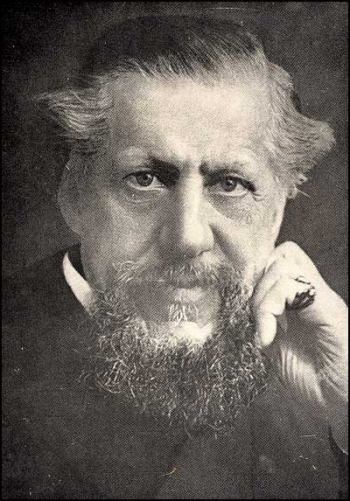Poet, linguist and Telegraph editor - meet the extraordinary Sir Edwin Arnold
I went to a meeting this week at the London headquarters of the Buddhist Society, where I was invited to sit in Sir Edwin Arnold's chair. An honour.
I went to a meeting this week at the London headquarters of the Buddhist Society, where I was invited to sit in Sir Edwin Arnold's chair. An honour.
I have always had a soft spot for Sir Edwin. An editor of The Daily Telegraph in the late 19th century, he was the very definition of the Victorian polymath. As a young man, he was the principal of Deccan College in Poona during the days of the Indian Mutiny. He was an Orientalist who spoke Hindi, Urdu, Sanskrit, Persian and Turkish; a journalist who could turn out articles on everything from blush roses to the Prusso-Danish war; a poet who was considered for Poet Laureate. A portrait hanging in the library of the Buddhist Society shows an imposing-looking man with a fine head of silver hair, a full beard and an unsettlingly penetrating gaze.
According to a memoir by his son Emerson, India was Arnold's first love, but he was obliged by circumstances to remain under grey Western skies and labour for more than 40 years in London on the staff of The Daily Telegraph''. He rose to the position of editor-in-chief. But he is best known for his epic, book-length poem about the life of the Buddha, The Light of Asia. Published in 1879, it was one of the first works to introduce Buddhism to the public at large. In recognition, on a visit to what was then Ceylon, he was presented with the yellow robe and begging bowl of a Buddhist monk - the first, and so far as I can determine only, editor of The Daily Telegraph ever to be accorded this honour.
Arnold's chair was presented to the Buddhist Society by his son in 1932. It is a handsome mahogany item with carved arms and legs. Attached to the back is a plaque explaining that in this chair Sir Edwin wrote much of The Light of Asia. Much, but not all.
Reading more about his life, I learned that he would also scribble lines of the poem while travelling on the District line between his home in Kensington and the newspaper's offices in Fleet Street.
According to his son, Arnold was as simple as a little child and would turn readily from his high thoughts and philosophies to enjoy any harmless and witty joke''.
His most peculiar whim was to carry a bag of gemstones, which he had acquired in Ceylon. Using his carpenter's tools he would bore holes in a staircase, a sideboard or a chair, and there secrete a topaz, garnet or sapphire - simply for the fun of it.
A chair...
I telephoned the Buddhist Society and asked whether I might pop back. Just like Sir Edwin, I took the District line. Arnold abhored time-wasting. He learned the Sanskrit alphabet by writing it out and hanging it over his dressing-table, and would exhort his children always to use the '10 minutes' of life''. On the Tube, one woman was using the 10 minutes'' to eat a packet of crisps. Another, in a hijab, studied an advertisement promising 50 per cent off top-secret hotels''. Nobody seemed to be composing an epic poem on the life of the Buddha, although the man slumped in the corner with his eyes closed might well have been contemplating, as Arnold put it: The fixed arithmetic of the universe, Which meteth good for good and ill for ill.''
At the Buddhist Society, I took a closer look at Sir Edwin's chair. Here and there were the sort of nicks and abrasions you would expect to find on a piece of furniture of this age, but no jewels. And then I found it. Running my finger along the gap between the arm of the chair and the upholstered seat I came across an indentation - deliberate, it seemed - just large enough to accommodate a topaz, a garnet or a sapphire. Of course, there was nothing in it. I walked into the library, and gazed up at the portrait of Sir Edwin. I could swear he was laughing.















